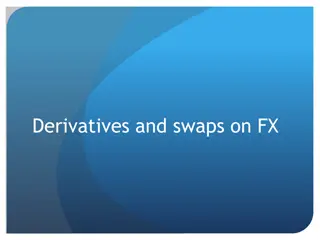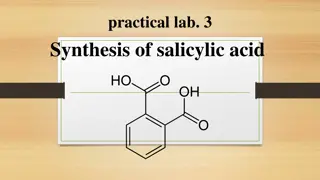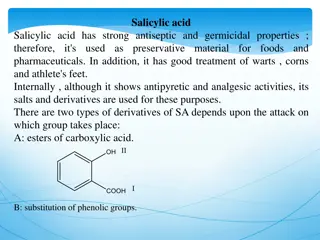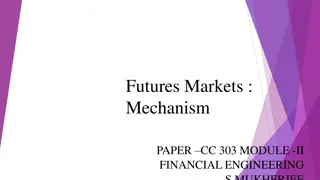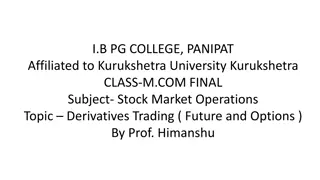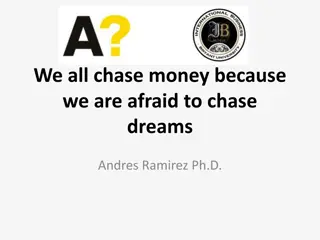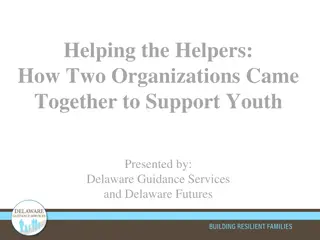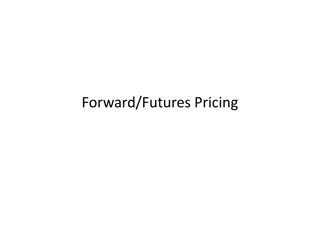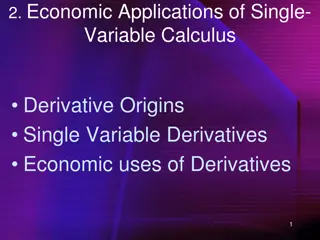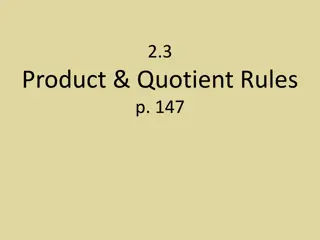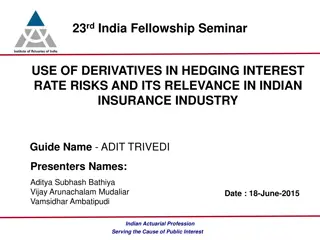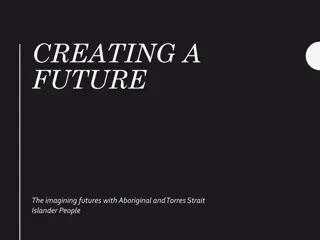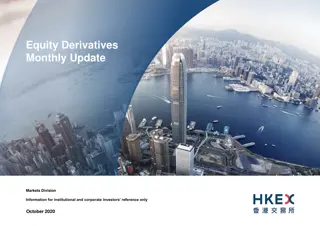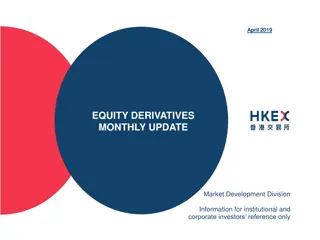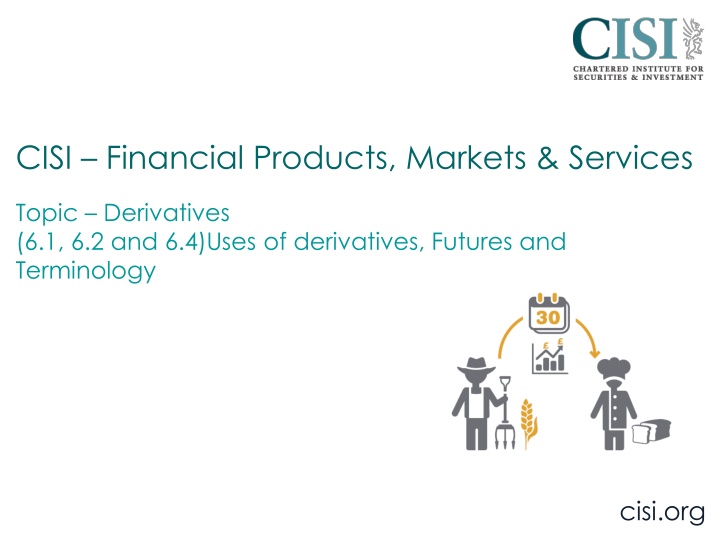
Derivatives: Uses, Futures, and Terminology
Explore the world of derivatives, where financial instruments derive their value from underlying assets. Discover how derivatives are used to speculate, hedge risks, and trade on exchanges. Learn about the history and significance of derivatives in financial markets.
Download Presentation

Please find below an Image/Link to download the presentation.
The content on the website is provided AS IS for your information and personal use only. It may not be sold, licensed, or shared on other websites without obtaining consent from the author. If you encounter any issues during the download, it is possible that the publisher has removed the file from their server.
You are allowed to download the files provided on this website for personal or commercial use, subject to the condition that they are used lawfully. All files are the property of their respective owners.
The content on the website is provided AS IS for your information and personal use only. It may not be sold, licensed, or shared on other websites without obtaining consent from the author.
E N D
Presentation Transcript
CISI Financial Products, Markets & Services Topic Derivatives (6.1, 6.2 and 6.4)Uses of derivatives, Futures and Terminology cisi.org
What are Derivatives? A Derivative is A financial instrument where the value is derived from the price of an underlying asset. The underlying asset could be financial or a commodity. They have been around hundreds of years originating back to agricultural markets cisi.org
What can be the underlying asset and why are derivatives used? The oil company has a guaranteed buyer and price for the fuel and guards against oil prices falling The airline has safeguarded against future rises in oil prices Jet Fuel The farmer has a guaranteed buyer and price for the hops and guards against falling hop prices The brewery has guaranteed hops to produce beer and can guard against increasing hop prices Hops The farmer has a guaranteed buyer and price for the wheat and guards against falling wheat prices The mining company has a guaranteed buyer and price for the copper and guards against falling copper prices The bakery has guaranteed wheat to make products and can guard against increasing wheat prices Wheat The manufacturer has the raw materials to produce products and guards against rises in the price of copper Copper The Investment bank will swap the type of interest rate offered on the company s The company will guard against the risk of interest rate rises and an increase in the cost of borrowing Interest rates cisi.org borrowings for a fee
Derivatives and their uses Speculating Hedging The motive of a party is to make money they have no interest in the underlying asset e.g. Banks Financial instruments are used to give exposure to price movements Reduces the risk of adverse price movements for the buyer and the seller FORWARDS FUTURES OPTIONS SWAPS A Derivative is A financial instrument where the value is derived from the price of an underlying asset. Financial Assets Bonds Shares Stock market indices Interest rates Commodities Oil Silver Wheat The underlying asset could be financial or a commodity. They have been around hundreds of years originating back to agricultural markets Trading of derivatives can take place: Either directly between counterparts - known as over-the-counter (OTC) Or, on an exchange - known as exchange-traded cisi.org
Futures A history Derivatives have been around for hundreds of year, traced back to agricultural markets: Farmers often needed a mechanism to guard against price fluctuations (From produce shortages and droughts) Farmers and merchants entered into forward contracts before the harvest period this removed much of the risk previously faced. Because these they were very popular and led to the opening of the world s first derivatives exchange, the Chicago Board of Trade (CBOT), in 1848. The exchange introduced a futures contract. They involved the purchase or sale of: A standardised quantity and quality of grain (such as 100 bushels of wheat containing no more than 5% moisture) for a price agreed now and for delivery on a stated future delivery date, such as three months later. Unlike the forward contracts that preceded it, these futures contract are traded on the exchange, rather than over the counter. cisi.org 1975 saw CBOT introduce the world s first financial futures contract.
Futures Features We have already seen examples of futures contracts in the last activity. 2. Agrees to pay a pre-specified amount for the delivery of a pre- specified quantity of an asset at a pre-specified future date (XXX of Jet fuel at xxx on 10.10.15) 4. Exchange Traded e.g. NYSELiffe orICE 1. Futures Contract It is a Legally binding obligation between two parties Buyer Seller 5. Standardised terms Only the price is negotiable quality, quantity, date and location is set by the exchange 3. Agrees to deliver the asset (Jet fuel) at the future date, in exchange for the pre-specified amount of money cisi.org
Futures - terminology Long Short Naked The seller of the future does not have the asset that will be needed if physical delivery of the commodity is required. The buyer Committed to buying the underlying asset at the pre-agreed price at a future date. The seller Committed to delivering the underlying asset in exchange for the pre-agreed price on the specified future date. Seller Futures Contract Legally binding obligation between two parties Buyer Open The initial trade. The trade is opened when it first enters a future. Can be a buyer (Opening a long position) or a seller (Opening a short position) Close Most physical assets don t end up being delivered. A closing sale is made by the buyer before delivery date. If it is not closed, the buyer receives the asset. Covered The seller has the underlying asset that will be needed for the physical delivery to take place. (Often the seller does not have ownership at the time) cisi.org
Futures Terminology - Naked and Covered Naked Position Covered Position The seller of the future does not have the asset that will be needed if physical delivery of the commodity is required. The seller has the underlying asset that will be needed for the physical delivery to take place. (Often the seller does not have ownership at the time) Seller If the futures contract is not closed out , Shell would need to fulfil the delivery of the specified quantity of jet fuel on the date specified at the specified price but would need to purchase the oil to fulfil the contract. If the futures contract is not closed out , Shell would need to fulfil the delivery of the specified quantity of jet fuel on the date specified at the specified price. If they are in this position, they already have the asset to fulfil the contract. Why would a buyer close out a futures contract? It goes back to the purpose of the futures contract and who the buyer is. In the case of the airline and oil company, the contract is not likely to be closed out as the airline has a genuine interest in the underlying asset (jet fuel) they need it to do business. Both parties are hedging. But the buyer could be a financial institution speculating on the price of the underlying asset and have no interest in the asset itself, therefore do not want physical possession of it. cisi.org



